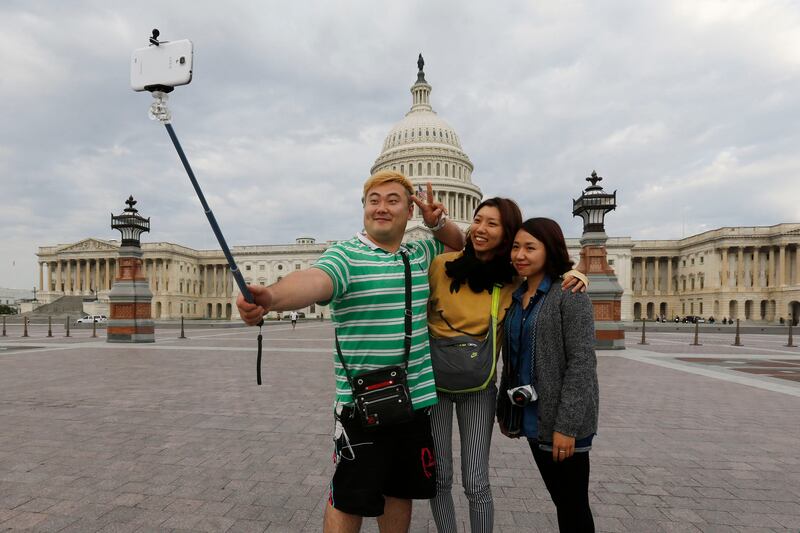On the mall in Washington yesterday morning, World War II vets stormed the shuttered World War II monument. In New York, the Statue of Liberty was closed. The South Dakota state government is trying to keep Mount Rushmore open. Campers in glorious Yosemite have been given 48 hours to get out.

The anecdotes from government-run parks and tourist states are symbolic, and make for good images of the real-world impact of a government shutdown. (There are certain upsides, of course. The Klan apparently canceled a rally it had planned at Gettysburg.) But they also speak to a larger truth. There’s a certain blitheness of spirit surrounding the impact of the shutdown. Most people at most companies simply showed up for their jobs as usual, and can easily conclude that it won’t matter much. But in some industries, including some really vital American industries, the impact of the government shutdown is immediate—and difficult.
Travel is a very big business in the U.S. I could tell you precisely how large a business it is, but the Bureau of Economic Analysis’s website is closed today. And the section of the Commerce Department’s website that contained very detailed data on tourism is likewise shuttered temporarily. However, the U.S. Travel Organization put out an annual report that estimates the impact of travel generally in the U.S. The report suggests 14.4 million total jobs are supported by travel, or one in every eight in the private sector. For 2013, it forecasts travel spending will be $889.1 billion, up 3.9 percent from $855.4 billion in 2012. New York City alone in 2011 welcomed (or didn’t welcome, as the case may be) 50.9 million tourists.
Of course, most tourists traveling in the U.S. visit sites run by the private sector—like Disney World, or Las Vegas. But federally-run sites are also among the largest attractions. Mount Rushmore gets three million visitors per year. That’s nearly four times the population of South Dakota. Without government entities, the 17.9 million tourists who visited Washington, D.C. in 2011 would have had little reason to go. An estimated 275 million people visit national parks each year. And without other government operations—the State Department, which processes and grants visas, the airports, customs officials—people wouldn’t be able to enter, exit, and move about the country.
While many of the jobs tourism supports may be low-paying, it is also a vital export industry. This is an important, little-understood point. When people from abroad come and spend money in the U.S., that’s considered an export. Every time you see a Brazilian at the National Gallery, Swedish backpackers in Yosemite, or Korean tour groups at Kennedy airport, you’re watching exports happen in front of your eyes. By contrast, when Americans spend money as they travel abroad, that’s considered an import. And in an era when the U.S. continually racks up large trade deficits (I’d link to the latest figures, but the site isn’t functioning today), and in which foreigners increasingly have the purchasing power to enjoy America, the ability to attract, process, and entertain tourists is of vital importance.
When they get money, foreigners like to come to America and see what it’s all about. By contrast, Americans are more insular. And so the U.S. runs a significant trade surplus each year. Indeed, the rapid growth in international tourism has been a key factor in bringing down the trade deficit in recent years. In 2011, some 62.3 million international visitors came to the U.S., up 5.6 percent from 2010. According to government figures, U.S. tourism exports have risen from $134.5 billion (a $31.2 billion trade surplus) in 2010, to $152.4 billion in 2011 and $168 billion in 2012. In 2012, the U.S. notched a record $50 billion trade surplus in tourism. For 2013, the U.S. Travel Association projects the number of international visitors will rise to 69.6 million, up from 67 million in 2012.
That’s a lot of economic activity. The U.S. Travel Association says tourism exports directly support 1.1 million jobs in the U.S. each year. That may be something of an exaggeration. But there’s no denying the significance of the tourism sector to the U.S. economy, and no denying the damage being inflicted on it by government shutdowns—and by the larger issue of chronic underfunding of the tourism infrastructure.
Economic analysts may believe that the shutdown’s biggest impact on export might be the temporary freezing of Export-Import Bank financing for commerce. But the failure to open the doors at the National Gallery, or to let the hordes of tourists disembark from the ferry onto Liberty Island, will be more damaging to the export economy.






